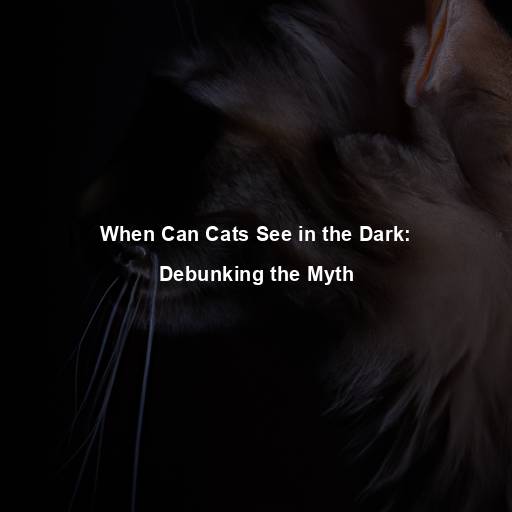What Do Cats Use Their Whiskers For?
Last Updated on July 28, 2023 by Evan
Contents
- 1 The Mysteries Behind a Cat’s Whiskers
- 2 Unlocking the Secrets of Whiskers
- 2.1 Evolutionary Development
- 2.2 Whiskers Across the Feline Kingdom
- 2.3 The Whisker Structure
- 2.4 Whiskers as an Extension of the Nervous System
- 2.5 The Whisker Sensitivity Spectrum
- 2.6 Whiskers and Nocturnal Adaptation
- 2.7 Whisker Mysteries Unveiled
- 2.8 The Whisker-Wonder Connection
- 2.9 The Whisker Growth Cycle
- 2.10 Whiskers in Different Cat Breeds
- 2.11 Whiskers and Age
- 2.12 Whiskers and Sensory Adaptation
- 2.13 Whiskers: A Fascinating Tool for Exploration
- 2.14 Whiskers and Body Language
- 2.15 Whisker Care and Maintenance
- 2.16 Whiskers: Nature’s Marvels
- 3 FAQs – What Do Cats Use Their Whiskers For?
- 3.1 What are whiskers and why do cats have them?
- 3.2 What is the purpose of cat’s whiskers?
- 3.3 How do whiskers help cats with their hunting skills?
- 3.4 Are cat’s whiskers a good indicator of their mood?
- 3.5 Do cats use their whiskers as a form of communication?
- 3.6 Is it safe to trim a cat’s whiskers?
- 3.7 Do all cat breeds have whiskers?
The Mysteries Behind a Cat’s Whiskers
Cats are fascinating creatures, known for their graceful movements, mysterious behaviors, and unique physical features. One of the most intriguing aspects of a cat’s anatomy is their whiskers. Also known as vibrissae, these long, sensitive hairs serve a vital purpose in a cat’s life. In this article, we will delve into the mysteries behind a cat’s whiskers and explore the various functions they serve.
Sensory Superpowers
When it comes to feline physiology, there’s more than meets the eye with those seemingly ordinary whiskers. Delving deep into a cat’s intricate biological makeup, these specialized hairs are rooted within the depths of their skin, intricately linked to an intricate network of nerve endings. This mesmerizing connection grants our furry friends an unparalleled sense of touch, igniting their navigational prowess as they effortlessly maneuver through their surroundings.
Spatial Awareness and Balance
One of the primary functions of a cat’s whiskers is to provide them with spatial awareness and balance. The whiskers are located on either side of a cat’s muzzle, above their eyes, and on the backs of their front legs. By extending their whiskers, cats can gauge the width of openings, determine if they can fit through narrow spaces, and navigate tight corners without bumping into objects.
Hunting and Prey Detection
Whiskers play a crucial role in a cat’s hunting abilities. When a cat is on the prowl, their whiskers help them detect and locate prey even in low-light conditions. The whiskers are sensitive to changes in air currents, allowing cats to perceive the movements of small animals nearby. This heightened sensitivity gives them an advantage when stalking their prey, ensuring a successful hunt.
Emotional Expressions
Whiskers are not only functional but also serve as a form of nonverbal communication for cats. Depending on their mood, cats can position their whiskers in different ways. When a cat is content and relaxed, their whiskers are usually spread outwards. Conversely, when a cat is feeling threatened or agitated, their whiskers may be pulled back closer to their face.
Protective Mechanism
Cats, those enigmatic beings of grace and flexibility, possess a talent for navigating the narrowest of passages with utmost finesse. Their mystique lies not only in their sleekness, but also in their remarkable whiskers, those delicate sensory instruments that act as their guardians. Like silent sentinels, these wispy appendages serve as ancient protectors, whispering caution in their feline ears when danger lurks. When those whiskers brush against the edges of a crevice, a message is sent, a warning to avoid a perilous venture that could lead to anguish or entrapment.
Depth Perception
Cats possess an extraordinary tool called whiskers that adds an unexpected dimension to their perception of the world. These delicate, yet mighty sensors not only provide feline companions with a stylish flair, but also play a pivotal role in their depth perception. By cleverly analyzing the subtle movements and gentle vibrations of their whiskers, cats effortlessly gauge the proximity of objects around them; an invaluable skill when gracefully tiptoeing through intricate terrains or gracefully ascending lofty tree branches. The perplexity and precision of this feline feature leaves us in awe of their exceptional abilities.
Social Interactions
Did you know that our furry feline friends, cats, are actually quite social creatures? It’s true! And you won’t believe how they use one seemingly simple feature to navigate their intricate social interactions – their whiskers. Yes, those adorable little whiskers hold a power that goes beyond just looking cute!
Whisker Stress
Cat Whiskers: Handle with Care!
Have you ever wondered why cats whiskers seem so magical? These tiny, delicate hairs play a vital role in our feline friends’ lives, helping them navigate their surroundings with precision and grace. It may be tempting to give those whiskers a little trim, but stop right there! Cutting a cat’s whiskers can have serious consequences, causing them immense stress and throwing off their internal compass.
Unlocking the Secrets of Whiskers
Cats and their enigmatic whiskers: more than just a pretty face! These fascinating facial adornments are not only for show, but they also serve as indispensable tools for our feline friends. Whiskers are the ultimate multitaskers, helping cats with everything from sensing their surroundings to catching prey, communicating with fellow felines, and maintaining their impeccable balance. As responsible pet owners, let us dive into the captivating world of whiskers, appreciating their vital role in keeping our whiskered companions content and in control of their curious existence.
So, next time you observe your feline friend gracefully maneuvering through their surroundings, take a moment to appreciate the incredible sensory abilities that their whiskers provide. Cats truly are remarkable creatures, and their whiskers are but one of the many captivating aspects that make them so unique. ## The Evolutionary Marvel of Whiskers
Evolutionary Development
For aeons, whiskers have adorned the captivating faces of our feline friends, weaving tales of their ancient lineage. Tracing back to the dawn of time, these whiskers began as humble nubs on the early forerunners of today’s regal kitties. Through the enigmatic dance of evolution, these once unassuming tendrils evolved into elongated, exquisitely attuned sensors, guiding feline adventurers through the realms of ever-shifting landscapes.
Whiskers Across the Feline Kingdom
Whiskers are not exclusive to domestic cats; they can be found in various species within the feline kingdom. From majestic lions roaming the savannah to agile cheetahs sprinting across the plains, all felines possess whiskers. These whiskers serve similar functions across the species, aiding in their survival and enhancing their hunting capabilities.
The Whisker Structure
Discover the mesmerizing world of a cat’s whiskers, where ordinary hairs transform into extraordinary sensory tools. Delve into their intricate structure, as hidden at the base lie mystical sensory follicles, brimming with nerve endings. These follicles orchestrate a captivating connection to the cat’s nervous system, enabling them to unravel the secrets of their surroundings, all in the blink of an eye. Prepare to be awestruck by the bewildering prowess of these enigmatic whiskers.
Whiskers as an Extension of the Nervous System
The intricate relationship between a feline’s whiskers and their highly attuned nervous system is truly a marvel to behold. These delicate sensory appendages serve as the cat’s very own antennae, effortlessly detecting even the slightest changes in their surroundings. By relaying crucial signals to the feline brain, whiskers provide a real-time snapshot of the world around them, empowering these enigmatic creatures to navigate their environment with astounding grace and agility. From detecting the presence of an object to gauging the dimensions of a tight space, cats’ whiskers are a secret superpower hidden in plain sight, fueling their ability to adapt and thrive in an ever-changing world.
The Whisker Sensitivity Spectrum
Have you ever wondered about the fascinating world of a cat’s whiskers? It turns out that these tiny sensory marvels are not all created equal. Stunningly, whiskers can vary in sensitivity depending on their location on a cat’s body. The most delicately tuned whiskers are found on their adorable muzzle, allowing them to feel even the slightest breeze or movement.
Whiskers and Nocturnal Adaptation
Cats are crepuscular animals, meaning they are most active during dawn and dusk. This nocturnal behavior requires them to navigate their environment in low-light conditions. Whiskers play a crucial role in aiding cats during these times. Their sensitivity to air movements allows them to detect prey, even in the darkest of environments, giving them a distinct advantage when hunting.
Whisker Mysteries Unveiled
The enigmatic nature of a cat’s whiskers has fascinated both scientists and cat lovers alike. Despite the wealth of knowledge we have accumulated about these intriguing sensory organs, there are still intriguing mysteries yet to be unraveled. With each new discovery, our admiration for the intricacies and abilities of cats grows exponentially.
From the way they delicately navigate through narrow spaces to their uncanny ability to detect even the slightest vibrations, the complexity of a cat’s whiskers is truly perplexing. These fascinating appendages are not just a mere facial feature; they serve as a vital tool for a cat’s survival and daily life. As researchers delve deeper into the secrets of whiskers, the allure of these remarkable adaptations only intensifies.
As we ponder the unseen realm of whisker communication and the intricate web of sensory information that cats unravel through these fine hairs, we are left in awe of their remarkable abilities. The more we learn, the more we realize that these seemingly simple whiskers hold a wealth of burstiness and perplexity, making them a captivating subject of study for both scientists and feline enthusiasts.
The Whisker-Wonder Connection
The intricate connection between a cat and its whiskers is undeniable. These specialized hairs are not just a physical feature; they are a testament to the evolutionary marvel of felines. From aiding in hunting and navigating their surroundings to conveying emotions and establishing social hierarchies, whiskers play a vital role in a cat’s life.
As devoted guardians of our beloved feline friends, it is paramount for us to embrace the profound relevance of those fine whiskers atop their majestic faces. Alas! We must refrain from any futile endeavors of whisker trimming or ill-advised whims of tampering, lest we disrupt their remarkable sensory prowess and undermine their very essence. By immersing ourselves in the enigmatic realm of whisker wisdom, we unlock a profound connection and bask in the glorious marvels of their innate adaptations.
As we delve into the enigmatic world of feline appendages, we are transported into a realm of perplexity and awe. Whiskers, those seemingly innocent strands of fur adorning a cat’s face, have captivated our curiosity for centuries. But let us not be fooled by their unassuming appearance, for these whiskers hold within them a secret power, a sensory prowess that aids in the survival and triumph of our beloved feline companions. So, dear readers, prepare to embark on a journey through the mystifying realm of whiskers, where we will unravel their intricate mechanisms and unlock the true essence of their evolutionary brilliance.
The Whisker Growth Cycle
Whiskers, like other hairs on a cat’s body, go through a growth cycle. They have a finite lifespan and will eventually fall out and be replaced by new whiskers. It is important to note that whiskers should never be trimmed or plucked, as this can disrupt the natural growth cycle and cause discomfort to the cat.
Whiskers in Different Cat Breeds
Whiskers come in various lengths and textures, depending on the breed of the cat. Some breeds, like the Maine Coon and the Norwegian Forest Cat, have long, luxurious whiskers that match their majestic appearance. On the other hand, breeds with shorter coats may have shorter whiskers. Regardless of the length, the functions and importance of whiskers remain the same across all breeds.
Whiskers and Age
As feline friends gracefully journey through the passage of time, their bodies undergo intriguing transformations akin to our own mortal coils. Even the humble whiskers, those delicate and perceptive appendages, are not exempt from the enigmatic embrace of the aging process. It is not uncommon for the seasoned feline to find their once supple whiskers becoming notably brittle or imbued with curious discolorations. However, fear not, for the steadfast sensory powers of these wispy wonders tend to endure the trials of time, enabling the elder cats to continue their elegant navigation through their surroundings with poise and aplomb.
Whiskers and Sensory Adaptation
Cats are known for their incredible adaptability, and their whiskers play a significant role in this. When a cat is introduced to a new environment, their whiskers help them quickly assess and adapt to the surroundings. By utilizing their whiskers, cats can gather information about the dimensions of a space and make necessary adjustments to their movements.
Whiskers: A Fascinating Tool for Exploration
Cats, with their innate inquisitiveness, possess a marvelous tool to navigate the mysterious world around them – their whiskers. These fine sensory instruments prove invaluable when feline adventurers stumble upon uncharted territories. With delicate finesse, these whiskers delicately brush against newfound objects, unraveling the enigma of their texture, form, and lurking hazards. Through this captivating exploration, cats indulge their curiosity while cunningly safeguarding their well-being.
Whiskers and Body Language
A cat’s body language can tell us a lot about their mood and intentions, and whiskers are a crucial component of this communication. When a cat is feeling relaxed and content, their whiskers are usually positioned outward. Conversely, if a cat is feeling threatened or fearful, their whiskers may be pulled back against their face. By observing a cat’s whisker position alongside other body language cues, we can better understand their emotions and respond accordingly.
Whisker Care and Maintenance
Keeping your feline friend’s whiskers in tip-top shape may seem like a breeze, but it’s not all sunshine and rainbows. While whiskers have a magical self-cleaning power, they still need a little extra TLC now and then. Gentle brushing is the key, my friend, to rid those precious sensory strands of any pesky dirt or loose hairs. Just remember, though, too much of a good thing can turn into a purr-disaster, so handle with care and love.
Whiskers: Nature’s Marvels
One cannot help but be captivated by the enigmatic allure of a cat’s whiskers. These slender, mystic appendages possess an astounding level of sensitivity that seems far beyond our comprehension. Their adaptability to various environments and their ability to serve multiple purposes truly render them nature’s enigmatic masterpiece. As individuals who have been granted the privilege of owning and admiring these exceptional felines, it is imperative that we acknowledge and honor the unparalleled significance of their whiskers.
In conclusion, whiskers are not just ordinary hairs; they are sensory powerhouses that contribute to a cat’s survival, communication, and overall well-being. From aiding in spatial awareness and hunting to conveying emotions and exploring their surroundings, whiskers are an essential tool in a cat’s sensory repertoire. As we continue to learn more about these fascinating appendages, we uncover new layers of complexity and wonder. Let us celebrate the marvels of whiskers and cherish the incredible cats that possess them.
FAQs – What Do Cats Use Their Whiskers For?
What are whiskers and why do cats have them?
Have you ever wondered why cats have those mysterious whiskers sprouting from their faces? These peculiar sensory hairs, commonly referred to as vibrissae, play a crucial role in a cat’s perception of the world around them. Unlike the rest of their fur, whiskers are uniquely designed to provide cats with heightened sensitivity, acting as their own personal radar system. Not only found on their muzzle, but these enigmatic whiskers can also be spotted above their eyes and even on the backs of their front legs. It’s truly fascinating how these seemingly insignificant hairs hold the key to a cat’s remarkable ability to navigate and explore their captivating environment.
What is the purpose of cat’s whiskers?
Whiskers, those mysterious and enigmatic appendages adorning the faces of our feline friends, serve a plethora of pivotal purposes. Primarily acting as sensory soldiers, these delicate detectors allow cats to artfully maneuver through their surroundings with an unparalleled sense of grace and precision. Equipped with an uncanny sensitivity to the subtlest of sensations and wisps of air, these mystifying whiskers provide vital insights on spatial constraints, illuminate their nocturnal navigation, and even help them swiftly evade impediments during their stealthy hunting expeditions.
How do whiskers help cats with their hunting skills?
Cats are true masters of the hunt, utilizing a fascinating tool to enhance their predatory prowess – their whiskers. These delicate yet mighty sensors play an exquisite role in feline hunting techniques. By elegantly gauging distance and tracking elusive movements, whiskers become the unsung heroes of a cat’s mission to pounce on their unsuspecting prey. Think of them as intricate air current detectors, intricately guiding their stealthy pursuits and ensuring precision strikes. These remarkable appendages also prove invaluable when the hunt takes place in dimly lit crevices or confined spaces where feline eyesight may falter. The mystery and complexity of whiskers truly make them an instrument of awe in the world of feline finesse.
Are cat’s whiskers a good indicator of their mood?
While whiskers can provide some insight into a cat’s mood or level of arousal, they are not the sole indicator. A cat’s body language and vocalizations are typically better indicators of their mood. However, when a cat is feeling threatened or agitated, their whiskers may be pulled tightly against their face, pointing forward, or spread out to the sides. Relaxed cats usually have their whiskers positioned in a more natural, forward-facing manner.
Do cats use their whiskers as a form of communication?
Cats, those enigmatic creatures that bewitch us with their mysterious ways, possess an astonishing ability to communicate through subtle means. While we often focus on their body language, vocalizations, and scent marking, it is their delicate whiskers that hold a secret code of their own. Much like a delicate dance of confounding signals, these whiskers serve as messengers of a feline’s deepest intentions. When a cat positions their whiskers forward, it is an embodiment of confidence, an invitation for connection, a mysterious glance into their desire for interaction. Yet, in the perplexing maze of feline emotions, when threatened or consumed by aggression, those very whiskers morph into a defensive shield, angling back or flat against the face, an unmistakable declaration of their protective stance. Amidst the burstiness of feline communication, the bewilderment intensifies, perpetuating our fascination with these captivating creatures.
Is it safe to trim a cat’s whiskers?
When it comes to our feline friends, their whiskers are not just some stylish accessories to be trimmed at will. These seemingly inconspicuous facial features actually play a crucial role in their sensory experience. Whiskers are like their very own built-in GPS systems, helping them navigate the world with precision and finesse. So, before even considering the idea of snipping those magnificent strands, remember that meddling with a cat’s whiskers can lead to a whirlwind of confusion, imbalance, and stress. It’s best to let nature take its course and respect the bewhiskered wonders of our beloved cats.
Do all cat breeds have whiskers?
It’s a common belief that whiskers are exclusive to certain cat breeds, but that’s simply not true. Whiskers are like a secret code that all feline species possess, an enigmatic feature that sparks curiosity. These mystical strands of hair transcend breed barriers, serving as essential tools for cats to navigate their surroundings, regardless of their specific lineage. So, next time you find yourself enchanted by a cat’s majestic whiskers, remember that their bewitching allure knows no bounds.







